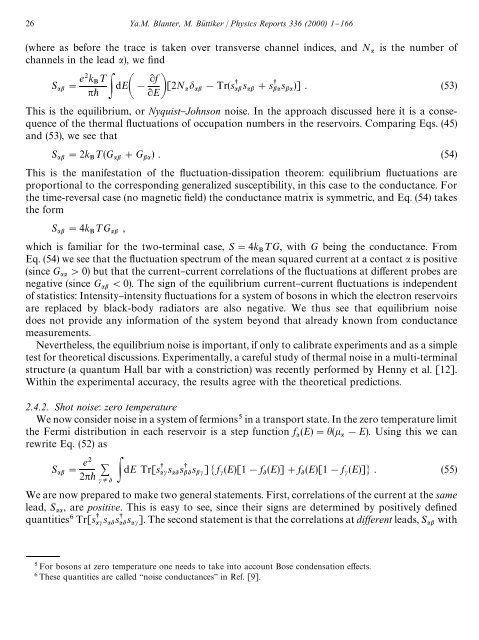shot noise in mesoscopic conductors - Low Temperature Laboratory
shot noise in mesoscopic conductors - Low Temperature Laboratory
shot noise in mesoscopic conductors - Low Temperature Laboratory
Create successful ePaper yourself
Turn your PDF publications into a flip-book with our unique Google optimized e-Paper software.
26 Ya.M. Blanter, M. Bu( ttiker / Physics Reports 336 (2000) 1}166<br />
(where as before the trace is taken over transverse channel <strong>in</strong>dices, and N is the number of<br />
<br />
channels <strong>in</strong> the lead ), we "nd<br />
S "<br />
ek ¹<br />
dE Rf<br />
! RE [2N !Tr(s s #s s )] . (53)<br />
<br />
This is the equilibrium, or Nyquist}Johnson <strong>noise</strong>. In the approach discussed here it is a consequence<br />
of the thermal #uctuations of occupation numbers <strong>in</strong> the reservoirs. Compar<strong>in</strong>g Eqs. (45)<br />
and (53), we see that<br />
S "2k ¹(G #G ) . (54)<br />
This is the manifestation of the #uctuation-dissipation theorem: equilibrium #uctuations are<br />
proportional to the correspond<strong>in</strong>g generalized susceptibility, <strong>in</strong> this case to the conductance. For<br />
the time-reversal case (no magnetic "eld) the conductance matrix is symmetric, and Eq. (54) takes<br />
the form<br />
S "4k ¹G ,<br />
which is familiar for the two-term<strong>in</strong>al case, S"4k ¹G, with G be<strong>in</strong>g the conductance. From<br />
Eq. (54) we see that the #uctuation spectrum of the mean squared current at a contact is positive<br />
(s<strong>in</strong>ce G '0) but that the current}current correlations of the #uctuations at di!erent probes are<br />
negative (s<strong>in</strong>ce G (0). The sign of the equilibrium current}current #uctuations is <strong>in</strong>dependent<br />
of statistics: Intensity}<strong>in</strong>tensity #uctuations for a system of bosons <strong>in</strong> which the electron reservoirs<br />
are replaced by black-body radiators are also negative. We thus see that equilibrium <strong>noise</strong><br />
does not provide any <strong>in</strong>formation of the system beyond that already known from conductance<br />
measurements.<br />
Nevertheless, the equilibrium <strong>noise</strong> is important, if only to calibrate experiments and as a simple<br />
test for theoretical discussions. Experimentally, a careful study of thermal <strong>noise</strong> <strong>in</strong> a multi-term<strong>in</strong>al<br />
structure (a quantum Hall bar with a constriction) was recently performed by Henny et al. [12].<br />
With<strong>in</strong> the experimental accuracy, the results agree with the theoretical predictions.<br />
2.4.2. Shot <strong>noise</strong>: zero temperature<br />
We now consider <strong>noise</strong> <strong>in</strong> a system of fermions <strong>in</strong> a transport state. In the zero temperature limit<br />
the Fermi distribution <strong>in</strong> each reservoir is a step function f (E)"( !E). Us<strong>in</strong>g this we can<br />
<br />
rewrite Eq. (52) as<br />
S "<br />
e<br />
2 dE Tr[s s s s ] f (E)[1!f (E)]#f (E)[1!f (E)] . (55)<br />
<br />
We are now prepared to make two general statements. First, correlations of the current at the same<br />
lead, S , are positive. This is easy to see, s<strong>in</strong>ce their signs are determ<strong>in</strong>ed by positively de"ned<br />
<br />
quantities Tr[s s s s ]. The second statement is that the correlations at diwerent leads, S with<br />
<br />
For bosons at zero temperature one needs to take <strong>in</strong>to account Bose condensation e!ects.<br />
These quantities are called `<strong>noise</strong> conductancesa <strong>in</strong> Ref. [9].
















